Report 2 7 November – 20 November 2019
This is the second in a series of weekly reports from the Centre for Research in Communication and Culture, Loughborough University on UK wide television and print media reporting of the 2019 UK General Election. These reports are published weekly throughout the campaign.
Report authors
David Deacon, Jackie Goode, David Smith, Dominic Wring, John Downey, Cristian Vaccari
This report has 6 sections:
- Levels of coverage of Brexit from week 1 to week 2.
- The wider issue agenda of the media election.
- Levels of media engagement with the election campaign.
- Who was news? Top 20 Politicians in coverage.
- First impressions: initial media evaluations of the ITV Leadership debate 19 November.
- Levels of coverage of political parties.
The results in this report are drawn from a detailed content analysis of election coverage produced on the weekdays (i.e. Monday to Friday inclusive) between 7and 20 November. The media sampled were:
Television: Channel 4 News (7pm), Channel 5 News (6.30pm), BBC1 News at 10, ITV1 News at 10, Sky News (10pm).
Press: The Guardian, The I, The Daily Telegraph, The Times, The Financial Times, The Daily Mail, The Daily Express, The Mirror, The Sun, The Star
All election-related news items in the television programmes were analysed. For the press, all election news found on the front page, the first two pages of the domestic news section, the first two pages of any specialist election section and the page containing and facing the papers’ leader editorials were coded. Read details on the methodology of the study. Intercoder reliability tests were conducted on all key variables and are ongoing.
Grateful thanks to our coding team: Eleanor Beestin, Jack Joyce, Gabriel Knott-Fayle Sarah Lewis, Han Newman, Dayei Oh, Nathan Ritchie, Louise Tompkins and Yingzi Wang.
Executive summary
The first week of the election was frenetic, dramatic and event filled. The second has been similarly memorable but not so dominated by domestic electoral politics. High profile stories relating to Prince Andrew, the potential impeachment of Donald Trump and even ITV’s ‘I’m a Celebrity Get Me Out of Here’ have cumulatively ensured the campaign has not attracted the same kind of news coverage it received in the previous week.
The first televised leaders’ debate between Boris Johnson and Jeremy Corbyn did, however, ensure they firmly cemented their places as the dominant election personalities. Overall, the media election remains dominated by the two main parties and their leaders. Jo Swinson succeeded in attracting more news coverage this week but was a distant third behind her rivals.
The second week has also seen the virtual disappearance of the ‘off-message’ or disaffiliated politicians who received considerable media attention in the first days of the campaign.
Analysis of the immediate follow-on coverage from the ITV debate confirm the newsworthiness of the event and how the structuring of this particular event will have compounded further the marginalisation of the minor parties. More than half of all items published in the 30 hours after the event made some reference to the ITV debate.
Most of these items provided either mixed or no evaluations of who ‘won’, but where evaluations were made (almost exclusively in the national press), Johnson’s performance was adjudged more positively than Jeremy Corbyn’s.
The traditional news media preoccupation with Electoral Process has ensured that this aspect remains the most prominent on television and in the newspapers. There has, however, been a marked decline in news coverage of this kind in the second week as the campaign has moved on from covering internal party intrigues and allegations of candidate misdemeanours in favour of more stories about substantive policy debates.
Brexit remains the foremost substantive issue in the campaign but levels of coverage have also diminished in the second week. In the extent to which coverage has engaged with the policy alternatives, the Prime Minister’s so-called ‘oven ready’ current withdrawal agreement exceeds considerably the attention given to alternatives including remaining, a further referendum or a no deal scenario. Soft-Brexit scenarios receive shortest shrift in terms of media exposure.
The issues of the Economy and Tax, particularly Labour’s plans for transforming policy in these domains, have helped ensure the topic has remained a marked feature of news media coverage. Reflecting this development, Shadow Chancellor John McDonnell has remained one of the most prominent campaigners. Not all of the related comment and analysis, especially in the press, has been favourable, however. By contrast McDonnell’s rival Sajid Javid has had a noticeably less high-profile campaign this week.
Health and Healthcare provision has become a more prominent feature of media coverage between weeks one and two. Labour has traditionally promoted the issue and the topic has already been a marked feature of its campaigning. The party’s spokesperson Jon Ashworth has enjoyed a relatively high profile in the campaign as have, to a lesser extent, his counterparts the current Secretary of State Matt Hancock and the Liberal Democrats’ Luciana Berger.
Other issues that have attracted more modest media coverage include Immigration, Environment and Scotland’s future in the Union. The former topic’s prominence is in part explained by Priti Patel’s announcement of a so-called ‘Australian-style’ points system for new migrants and Len McCluskey’s opinions of Labour’s policy on free movement of workers.
Section 1: Is it still the Brexit campaign?
It was widely anticipated that Brexit would dominate the 2019 General Election, with several newspapers such as the Daily Mail using the strapline ‘the Brexmas election’ when collating their coverage. This has proven a contentious presentational decision when made by Broadcasters.
Earlier in the second week of the campaign Labour complained to regulators Ofcom that Sky TV’s use of ‘the Brexit Election’ in branding their coverage breached impartiality rules. Ofcom rejected this complaint concluding it represented ‘a reasonable editorial judgment’ given the political context of the campaign.
But beyond the campaign branding by media outlets, to what extent has Brexit dominated media content?
Table 1.1 compares (a) the percentage of election items1 where Brexit appeared as an issue and (b) the percentage of occasions where Brexit was the main focus of an item.
| Week one | Week one | |||
|---|---|---|---|---|
| TV | Press | TV | Press | |
| % | % | % | % | |
| % appearance as an issue | 42 | 30 | 23 | 21 |
| % appearance as main item focus | 17 | 9 | 8 | 6 |
Notes: Percentages based on the total number of items each week
1 This is a different method of calculation to that used in Tables 1.1 and 1.2 in that it is based on the number of items coded rather than the number of times an issue was identified.
Key findings
- The prominence of Brexit has waned in the second week of the formal campaign across TV and press coverage.
- There was a 19 percent reduction in week 2 in the number of TV news items that addressed Brexit
- There was a 9 percent reduction in week 2 in TV items that had Brexit as their main focus.
- There were declines by both measures in press coverage in week 2, but these were not as steep as with TV coverage.
Figure 2.1 compares which of the main Brexit alternatives2 has received most media attention in the campaign so far.
Figure 2.1: Brexit alternatives in all Election news Coverage
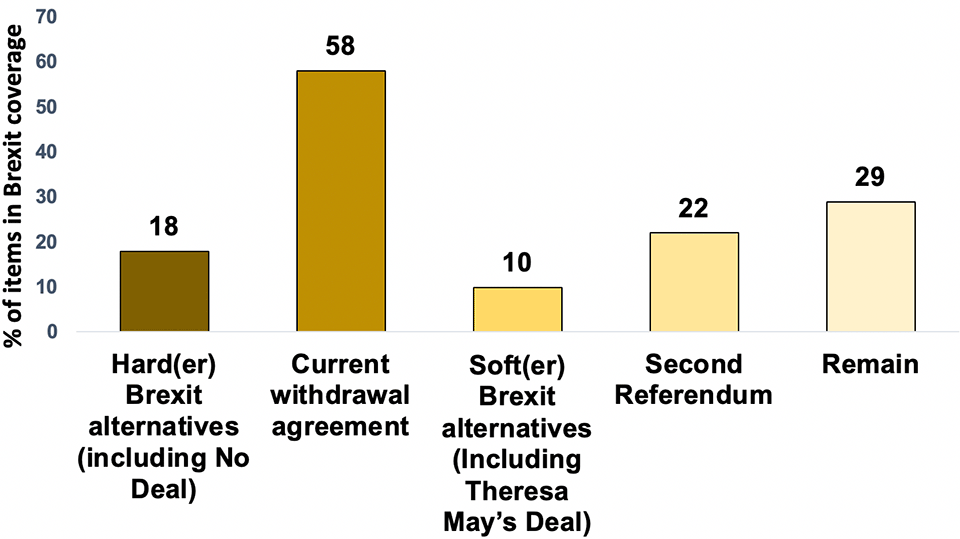
Note: percentages= (a manifest mention of a Brexit proposal/ total number of items in which Brexit appeared as an issue) *100. More than one Brexit alternative can be coded per item, therefore percentages are separate and do not add up to 100%.
2 Labour’s Brexit policy combines the negotiation of a ‘softer’ Brexit deal than the current withdrawal agreement that would then be put to a second referendum. Both Brexit alternatives would be coded if each facet of Labour’s policy was mentioned clearly. If not, only the aspect referred to was noted.
Key findings
- The Prime Minister’s current withdrawal agreement has so far received twice as much coverage as the next most prominent Brexit alternative (remaining in the EU).
- Discussion of ‘No Deal’ and other ‘Hard(er)’ Brexit alternatives received less than a third of the coverage given to the current withdrawal agreement.
- Soft(er) Brexit alternatives (e.g. Norway +, membership of the Customs union, Theresa May’s withdrawal agreement) have received least coverage, even though this is a component of Labour’s Brexit policy.
- The prominence of the Second Referendum alternative reveals that it is this aspect of Labour’s policy that is receiving most media attention.
- The emphasis on Brexit alternatives that are furthest removed from the terms of the Prime Minister’s withdrawal agreement (i.e. revoking the referendum or revisiting it) suggests a polarisation in the presentation of the policy alternatives.
Section 2: The issue-agenda of the media campaign
To provide context to these figures, Table 2.1 compares the prominence of all issues in TV and newspaper coverage in weeks 1 and 2 of the campaign.
Table 2.1: Issue in week 1 – 2
| Week 1 | Week 2 | |
|---|---|---|
| % | % | |
| Business/ economy/ trade | 8.7 | 10.4 |
| Constitutional/ legal/ judicial issues | 1.1 | 0.9 |
| Standards/ corruption/ scandals /sleaze | 2.9 | 3.3 |
| Crime/ law and order | 0.4 | 2.2 |
| Defence/ military/ security/ terrorism | 3.8 | 1.9 |
| Education | 1.4 | 0.5 |
| Electoral process | 40.5 | 29.5 |
| Employment | 1.4 | 2.0 |
| Environment | 2.9 | 4.1 |
| Brexit | 16.2 | 12.7 |
| Other EU | 0.1 | 0.4 |
| Farming/ agriculture | 0.2 | 0.4 |
| Other foreign policy | 0.1 | 0.1 |
| Media policy issues | 0.2 | 1.4 |
| Health and health care | 4.4 | 8.5 |
| Housing/ property issues | 0.2 | 0.6 |
| Local Government in UK | 0.4 | 0.2 |
| Scotland /Wales/ NI | 2.0 | 2.5 |
| Public services | 3.0 | 2.1 |
| Immigration/ border controls | 2.3 | 4.5 |
| Minorities/ religion/ sexuality | 1.8 | 1.9 |
| Social Security | 1.2 | 1.2 |
| Taxation | 2.7 | 6.9 |
| Transport | 0.5 | 0.6 |
| Women’s issues | 1.1 | 0.6 |
| Other | 0.2 | 0.6 |
Note: percentages = (number of appearance of an issue/ all issues *100)
Key findings
- Coverage of the Electoral Process itself was very prominent in the first week of the campaign, reflecting the launch of the campaign, sudden resignations of frontbench politicians, assorted political gaffes, and intrigues as to which parties were going to stand and the seats they were planning to contest. Levels of process coverage have reduced in the second week, as the parties have started to (pre) launch manifestos and mobilise their core campaign messages.
- As noted earlier, Brexit has been by far been the most significant substantive policy issue in news coverage of the opening stages of the campaign, but its prominence has diminished going into the second week.
- Business/ Economy/Trade has marginally increased its significance in week 2 coverage (8.7 percent to 10.4 percent)
- Health and the future of healthcare has become a more marked feature of election coverage almost doubling from the first to the second week (4.4 percent to 8.5 percent).
- Coverage of taxation has more than doubled, rising from 2.7 percent of all issues to 6.9 percent.
- Interest in immigration has increased, also nearly doubling from the first to the second week, but it has not achieved as much prominence as the topics above (2.3 percent to 4.5 percent).
- The Environment has been an issue in part reflecting the high-profile coverage of the difficulties caused by widespread flooding around the country in week 1. The receding of the flood waters has not led to a reduction in environmental related coverage (2.9 percent to 4.5 percent).
Section 3: Media engagement with the campaign
Table 3.1 extends the weekly comparisons developed above to assess the amount of coverage given to the election by mainstream national news outlets.
| Week 1 | Week 2 | % +/- | |
|---|---|---|---|
| TV (seconds) | 21207 | 20028 | -6% |
| ‘Red Top’ newspapers (cm2) | 27125 | 21994 | -19% |
| Mid-market press (cm2) | 44955 | 40812 | -9% |
| Quality press (cm2) | 66846 | 52893 | -21% |
Notes: ’Red Top’ press=The Mirror, Star and Sun; the Mid-Market press=Mail, Express and the I, Quality press=Guardian, Times, Ft and Telegraph
Key findings
- There was a marked reduction in the amount of election related coverage across all mainstream media sectors.
- The largest reduction was in the ‘Quality’ press (21 percent less coverage in the newspaper sections sampled in this study), closely followed by the most popular ‘Red top’ newspaper titles (-19 percent).
- The mid-market newspapers saw a 9 percent reduction.
- The smallest reduction was in TV News (down 6 percent).
- These reductions are mainly explained by the displacement effect of other major breaking news stories during the week, in particular, the controversy created by Prince Andrew’s televised interview about his links to the sex offender Jeffery Epstein and significant developments in the US Presidential impeachment hearings, and assorted items related to the beginning of ITV’s I’m a Celebrity series.
Section 4: Who was news? Top 20 Politicians in coverage
Table 4.1 lists the twenty most prominent politicians in news coverage of the second week of the campaign.
Table 4.1: Top 20 Individuals in news coverage (14 – 20 November)
| % of items (Wk2) | % of items (Wk 1) | ||
|---|---|---|---|
| 1 (1) | Boris Johnson (Con) | 40.4 | 20.8 |
| 2 (2) | Jeremy Corbyn (Lab) | 31.3 | 18.8 |
| 3 (8) | Jo Swinson (LibDem) | 7.5 | 4.5 |
| 4 (3) | John McDonnell (Lab) | 6.9 | 13.6 |
| 5 (4) | Nigel Farage (Brexit) | 6.7 | 11.4 |
| 6 (11) | Jonathan Ashworth (Lab) | 4.2 | 2.5 |
| 7 (20) | Priti Patel (Con) | 3.0 | 1.6 |
| 8 (8) | Nicola Sturgeon (SNP) | 2.5 | 4.9 |
| 9 (-) | Len McCluskey (Lab/Unite Union) | 2.2 | - |
| 10 (-) | Robert Buckland (Con) | 2.0 | - |
| =11 (-) | Diane Abbott (Lab) | 1.7 | - |
| =11 (-) | Michael Gove (Con) | 1.7 | - |
| =11 (-) | Matt Hancock (Con) | 1.7 | - |
| =14 (-) | Luciana Berger (LibDem) | 1.5 | - |
| =14 (12) | Andrew Gwynne (Lab) | 1.5 | 2.5 |
| =14 (-) | Brandon Lewis (Con) | 1.5 | - |
| =14 (-) | Dominic Raab (Con) | 1.5 | - |
| =17 (-) | Sian Berry (Green) | 1.2 | - |
| =17 (5) | Sajid Javid (Con) | 1.2 | 8.9 |
| =20 (-) | Jonathan Bartley (Green) | 1.0 | - |
| =20 (19) | James Cleverly (Con) | 1.0 | 1.6 |
| =20 (-) | Ed Davey (LibDem) | 1.0 | - |
| =20 (-) | Sue Hayman (Lab) | 1.0 | - |
Notes: percentages= individual’s appearance/ total number of items*100
Key findings
- This has been a highly presidential week with a marked focus on the two major party leaders. This reflects the impact of Tuesday’s debate between them (and controversially them alone) on the way the campaign has been covered.
- Jo Swinson’s attempts to reassert the importance of the Liberal Democrats in this, the week of the party’s manifesto launch, is reflected in her being the third most prominent campaigner. Her ranking has, however, been achieved with less than a quarter of the coverage afforded Jeremy Corbyn in second place. More broadly this outcome adds to the further marginalisation of women we noted during the opening part of the campaign.
- John McDonnell remains a high-profile campaigner, reflecting the interest in Labour’s economic programme. By comparison his rival Sajid Javid has been far less newsworthy this week.
- Nigel Farage and Nicola Sturgeon remain in the Top 10 reflecting, respectively, their determination to stop and enable a further referendum on EU membership as well as the SNP leader’s desire for another vote on Scottish Independence.
- The prominence of the relevant spokespeople (Jon Ashworth, Luciana Berger and Matt Hancock) reflects the increased coverage of health.
- Priti Patel and her colleague Robert Buckland both make the Top 10 reflecting the coverage devoted to the Conservatives’ plans for immigration and the life sentencing of child killers.
- Almost all of the rebels, retirees and ‘off-messengers’ that featured last week have fallen out of the top 20 (e.g. Jacob Rees-Mogg [Cons], John Woodcock [ex-Labour], Ian Austin [ex-Labour], Tom Watson [Lab]).
Section 5: First impressions: initial media evaluations of the ITV Leadership debate of 19 November
An average audience of 6.7 million people watched the leadership debate between Boris Johnson and Jeremy Corbyn on ITV on Tuesday 19 November.
A YouGov poll conducted on the evening of the debate asking for the public’s evaluation of the respective performances showed a narrow victory for Johnson (when asked who performed best overall 51 percent said Johnson, 49 percent said Corbyn). Figure 5 presents the initial evaluations made by journalists of the respective performances in the 30 hours after the event.
Figure 5: All media evaluation of Johnson & Corbyn in first ITV Leadership debate
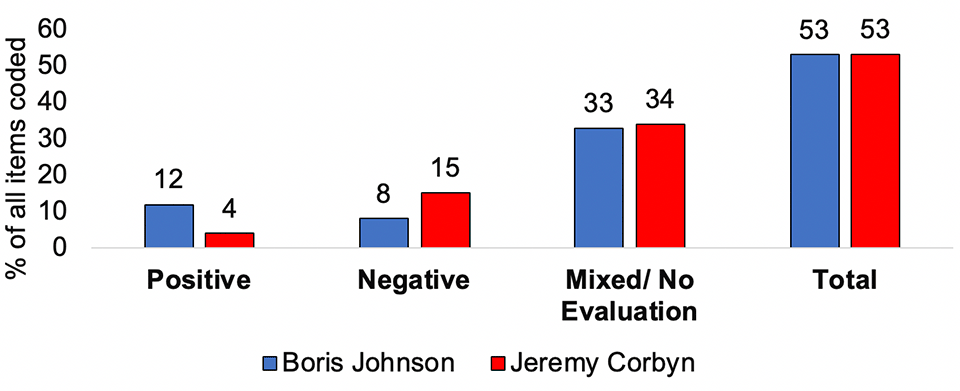
Notes: The percentages are based on the analysis of 103 election related news items published between 10pm on 19 November and 11.59pm on 20 November.
Key Findings
- More than one in 2 of all election news reports made some reference to the ITV leadership debate in the 30 hours after the event. In contrast, Jo Swinson’s one-to-one interview broadcast later at 10pm was referred to in in 13 percent of coverage (NB Swinson’s interview gained marginally more coverage than the accompanying interviews with Nigel Farage, Nicola Sturgeon and Sian Berry).
- Positive media evaluations of Johnson’s performance were almost double the negative evaluations whilst negative evaluations of Corbyn were almost quadruple the positive evaluations. As a whole media evaluations were more negative to Corbyn than the public’s view and more positive to Johnson.
- These evaluative differences were almost entirely due to press evaluations. Almost all TV coverage provided mixed or no evaluations.
Section 6: Levels of coverage of political parties
Figure 6.1 compares the levels of coverage3 of the political parties on TV news during the weekday coverage between 7 and 20 November inclusive. Figure 6.2 provides the same comparison for press coverage.
Figure 6.1: News presence of parties in national TV news (7-20 November)
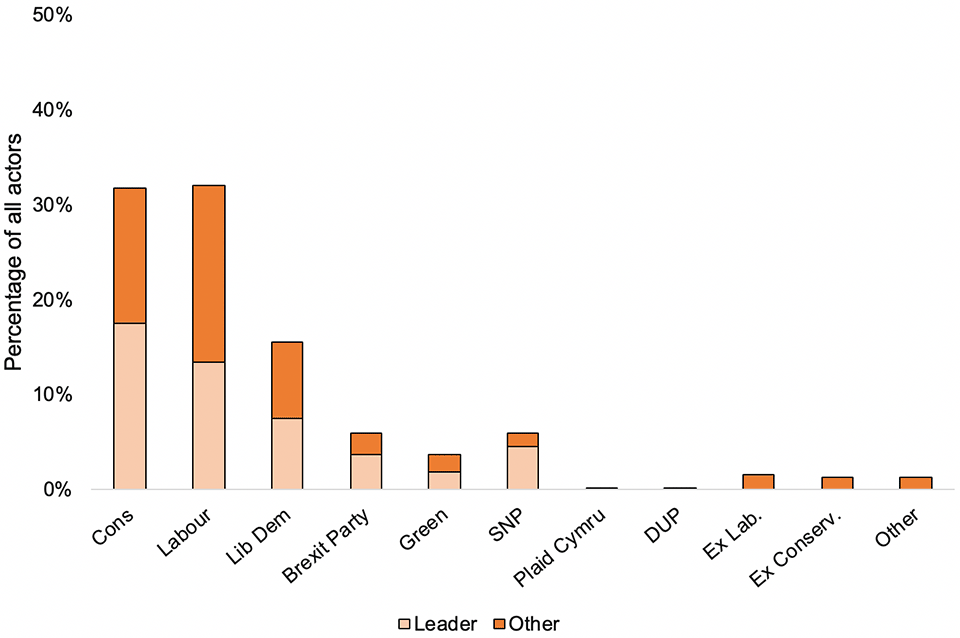
3 To be coded as ‘present’ a political representative needed to have an active role within the item. They could be counted even if they were not quoted, but there had to be a clear and substantial attribution to them of a speech act or action. Up to 5 politicians could be coded per item.
Figure 6.2: News presence of parties in national newspapers (7-20 November)
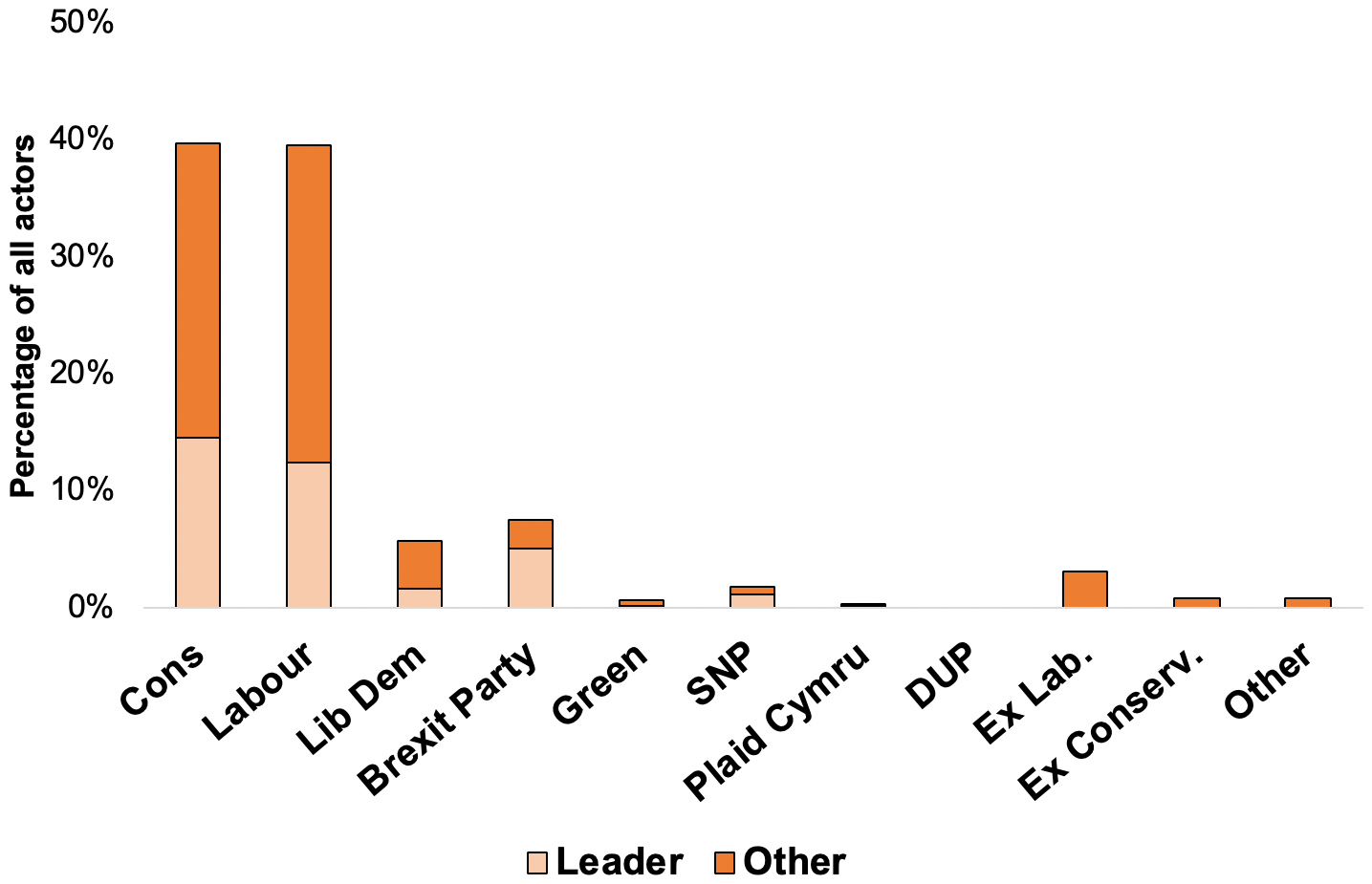
Key findings
- The two main parties continue to dominate press and TV coverage. In the press, coverage of those representing the two main parties has amounted to 79%. This coverage has been shared almost identically between the two, at 39.7% for the Conservatives and 39.6% for Labour. In TV coverage, their combined presence was 64% - again, this was near-identical, at 31.8% for the Conservatives and 32.1% for Labour.
- Each of the two main parties have received double the prominence that the Lib Dems have received on TV, whose coverage has comprised 16% of all appearances. The Brexit Party and the SNP reached TV coverage of 6% each, while the Green Party’s presence amounted to 4%.
- The Brexit Party has been more prominent so far in the press than the Lib Dems, totaling 7.5% of all appearances compared to the Lib Dems’ 6%.
- Former Labour party politicians (3.1%) have been more prominent than former Conservative party politicians (0.8%) in the press. On TV former Labour politicians have been less prominent than in the press at 1.6%, while former Conservative politicians have been slightly more prominent at 1.3% of all party actor appearances.
- Overall, the presence of these outsiders is receding as the campaign gains momentum.
- Coverage of the Green Party, SNP, Plaid Cymru and DUP amounted to 10% in TV coverage, but only 3% of press coverage.
- There was only one appearance from a DUP politician across all media this week – in TV coverage.
Figure 1.3 re-contextualises the above data and compares how prominent party leaders have been in in news presence so far compared with other members of their parties, including potential cabinet ministers and constituency candidates.
Figure 1.3: news presence of party leaders vs other politicians (TV and Press 7-20 November)
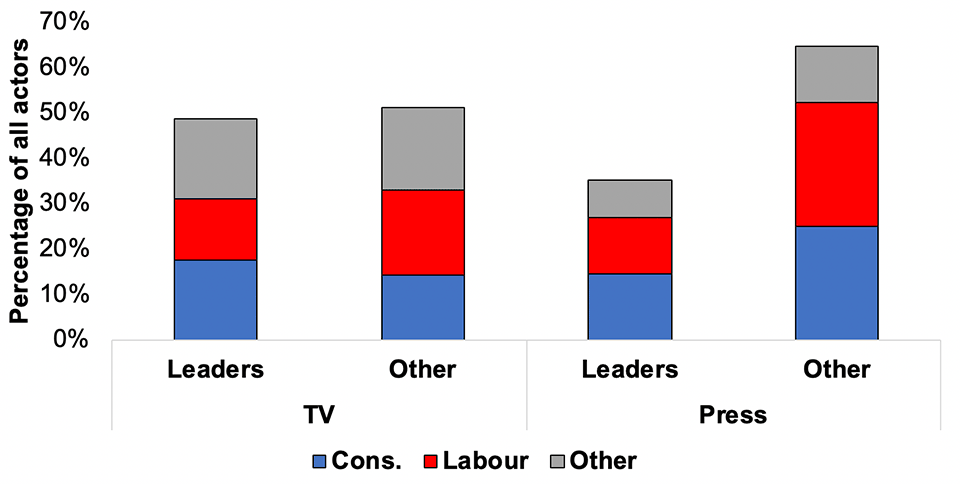
Notes: Percentages sum to 100% within each media type. ‘Other’ party leaders category includes the leaders of the Lib Dems, Brexit Party, Green Party, SNP and Plaid Cymru.
Key findings
- In news presence terms, television coverage of party leaders has placed them on parity with all other politicians combined.
- In the press, however, other politicians are more widely covered. Here, the ratio is closer to 1:2 (leaders:others), rather than the approx. 1:1 ratio of TV.
- While Boris Johnson tends to appear and is quoted more frequently than Jeremy Corbyn on TV and in the press, Labour politicians appear and are quoted more frequently than Conservative politicians on TV and in the press.